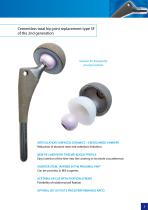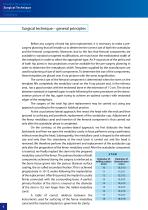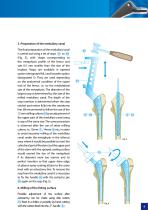
Catalog excerpts

Cementless femoral stem – type SF Cementless Femoral Hip Joint Components
Open the catalog to page 1
Implant Description Surgical Technique Instrumentation Set Catalogue The cementless stem of a total hip joint replacement type SF of the 2nd generation was designed using the latest knowledge and experience with cementless endoprostheses. It is made of titanium alloy and the most modern technology of surfacing with CNC-controlled machines is used during its manufacturing. The surface is conditioned with plasma coating of bioactive titanium oxide layer that ensures full biocompatibility of the implant. The instruments ensure easy implantation and thorough fixation. A wide size series...
Open the catalog to page 2
Cementless total hip joint replacement type SF of the 2nd generation Solution for biologically younger patients ARTICULATION SURFACES: CERAMICS – CROSSLINKED UHMWPE Reduction of abrasive wear and osteolysis limitation. NEW PE-LINER WITH TWELWE-EDGED PROFILE Easy insertion of the liner into the covering in its whole circumference. SHORTER STEM, TAPERED IN THE PROXIMAL PART Can be used also in MIS surgeries. ACETABULAR CUP WITH FIXATION SCREWS Possibility of rotation-proof fixation. OPTIMAL SET AS TO ITS PRICE/PERFORMANCE RATIO
Open the catalog to page 3
Implant Description Surgical Technique Instrumentation Set Catalogue Examples of supplied templates for comparison with X-ray pictures STANDARD STEM TAPERED STEM TOTAL HIP JOINT REPLACEMENT STEM S.F. Ø 11 SIZE 2 MAGNIFIED BY 20% FOR COMPARISON WITH X-RAY PICTURE
Open the catalog to page 4
STANDARD STEM TAPERED STEM TOTAL HIP JOINT REPLACEMENT STEM S.F. Ø 17 SIZE 8 MAGNIFIED BY 20% FOR COMPARISON WITH X-RAY PICTURE
Open the catalog to page 5
Implant Description Surgical Technique Instrumentation Set Catalogue Before any surgery of total hip joint replacement, it is necessary to make a presurgery planning that will enable us to determine the correct size of both the acetabular and the femoral components. Moreover, due to the fact that femoral components are available in standard or tapered modifications, we must know the mediolateral width of the metaphysis in order to select the appropriate type. An X-ray picture of the pelvis and of both hip joints in two projections must be available for the pre-surgery planning in order to...
Open the catalog to page 6
Surgical Technique Perforator 1 shall be used only at posterior approach when the patient is positioned on his/her side (Fig. 1). At antero-lateral approach, this instrument is not used after the resection of the head. When using the perforator, the hole must be located in fossa piriformis. 2. Resection of the head The head is resected using an oscillatory saw (Fig. 2). In case of a posterior approach, the head is resected only after the use of the perforator (1) and of the milling 1 cutters (3) to 12 with cylindrical stem ac3 cording to point 3. The perforator and the cutters can be fixed...
Open the catalog to page 7
Implant Description Surgical Technique Instrumentation Set Catalogue 3. Widening of entrance to the metaphysis part of the canal A window-chisel 16 is used to widen the metaphysis part of the medullary canal under the osteotomy line (Fig. 3). The point of the chisel must run along the interior lateral surface of the cortical bone. The orientation of the chisel must keep the planned anteversion of the femoral component (10 to 15°). 4. Milling of the medullary canal Special milling cutters 3 to 12 with cylindrical stem are used to mill the medullary canal (Fig. 4). First, milling cutters of...
Open the catalog to page 8
5. Preparation of the medullary canal The final preparation of the medullary canal is carried out using a set of rasps 17 to 34 (Fig. 5), with shape corresponding to the metaphysis profile of the femur and size 0.5 mm smaller than the size of the implant. Rasps are available in tapered option (designated ML) and broader option (designated S). They are used depending on the anatomical condition of the upper end of the femur, i.e. on the mediolateral size of the metaphysis. The diameter of the largest rasp is determined by the size of the milled medullary canal. The depth of the rasp...
Open the catalog to page 9
Implant Description Surgical Technique Instrumentation Set Catalogue 7. Preliminary test of articulation (on the rasp) Preliminary articulation is carried out using a plastic testing head 37 to 40 fixed on the cylindrical neck of the rasp (Fig. 7). Testing heads are available in four options differing by the neck length – S, M, L, XL. These heads are intended for test of articulation into testing inserts of cementless cup covering. To remove the rasp from the medullary canal we use the handle 35 with the extractor pin 45 (see Fig. 5). 8. Insertion of femoral component The cementless...
Open the catalog to page 10
9. Final test of articulation (of the femoral component) The final test of articulation is carried out using a test or a polyethylene articulation liner. One of the four testing plastic heads 41 to 44 is used for this test of articulation (Fig. 9) and an appropriate metal or ceramic head is selected on the basis of this test. Final articulation is carried out using the head inserting instrument 15 (Fig. 10). 11. Final result of the surgery Position when the head has been articulated into the acetabular cup (Fig. 11).
Open the catalog to page 11
Implant Description Surgical Technique Instrumentation Set Catalogue The set of instruments is placed in two cassettes allowing a clear lay-out of the instruments not only during transportation, storage and preparation, but also during the surgery. The lay-out of the instruments in the sieve cassette corresponds to pictures in the surgical technique manual. During transportation, the cassettes are placed in a container allowing sterilization.
Open the catalog to page 12
INSTRUMENTS FOR APPLICATION OF CEMENTLESS STEM TYPE SF LAY-OUT - CASSETTE II Cassette with lay-out of instruments II 1pc 301012 Window-chisel for femoral stem 1pc 304025 Rasp for cementless femoral stem - type SF/S, size 1 1pc 304030 Rasp for cementless femoral stem - type SF/S, size 2 1pc 304032 Rasp for cementless femoral stem - type SF/S, size 3 1pc 304034 Rasp for cementless femoral stem - type SF/S, size 4 1pc 304036 Rasp for cementless femoral stem - type SF/S, size 5 1pc 304038 Rasp for cementless femoral stem - type SF/S, size 6...
Open the catalog to page 13All Beznoska catalogs and technical brochures
-
SKIN STAPLER 35W
1 Pages
-
Cementless cup – type SF
20 Pages
-
Radial Head Replacement
12 Pages
-
Humeral head resurfacing
12 Pages
-
Hip Joint Head Replacements
8 Pages
-
Cemented femoral stem - type CSC
16 Pages
-
Hip Hemiarthroplasty – type CSB
20 Pages
-
Cerclage System
12 Pages
-
UNIQUE MANUFACTURING METHOD
1 Pages
-
Implants for Traumatology
16 Pages
-
Revision systems
32 Pages
-
Implants for primary surgery
44 Pages
-
Individual oncological implants
24 Pages























